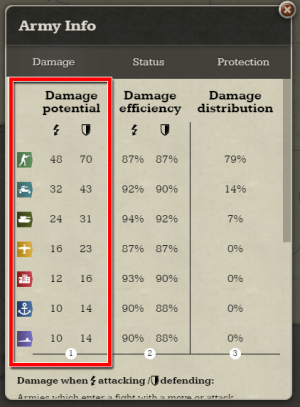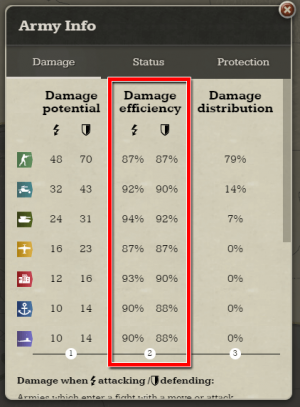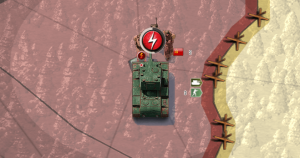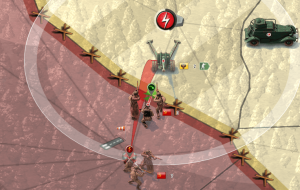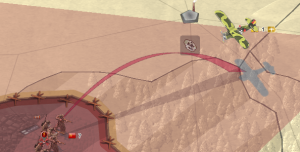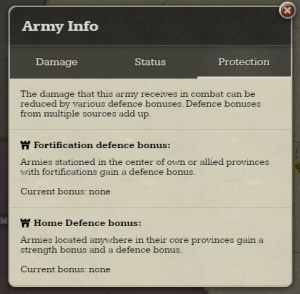COMBAT
From Call of War Wiki
Conquering provinces
When combat takes place in the center of a province and the defending army of the province is defeated, the attacking army will conquer the province immediately. If no defending army is stationed in the province, the province is also conquered immediately. If armies of multiple nations attack the same province, then the army which deals the final blow on the defending army will conquer the province. If the province is empty, then the nation which arrives first at the province conquers it.
Combat Phases
Combat is triggered when one army attacks another army. In combat damage is exchanged every 30 minutes, when combat cycles through the following phases:
- Calculation: The damage potential for each army is calculated based on its damage efficiency.
- Reduction: The damage potential is reduced by defence modifiers of the receiving army.
- Distribution: The reduced damage is distributed within the other army based on its army composition.
- Steps 1 to 3 are repeated after a cooldown of 30min, until one army is defeated or combat is ended otherwise.
In speed game rounds the combat cooldown can be faster, as this value refers to ingame time.
It is also possible that both armies attack each other, in which case two combat cycles with all 4 phases would happen simultaneously (see attacking and defending section below), thus speeding up the resolution of the exchange
Entering combat
Melee combat
Melee combat is triggered when 2 armies are within close combat range of each other on the map.
- The close combat range is 5 (game distance units).
When units enter melee combat they are locked in combat until one side is defeated. Melee combat is not triggered when:
- Allied armies meet.
- Allied means diplomacy settings of right of way, shared map or shared intelligence.
- Neutral armies (at peace) meet on sea, as long as their fire control settings are set to fire at will, return fire or hold fire.
- One of the armies is invisible to the other army and has its fire control settings set to return fire or hold fire.
Ranged combat
Ranged combat is triggered when an enemy unit enters the attack range of a ranged unit. Due to latency combat can also be triggered with a small delay. The start of ranged combat also depends on the fire control setting (High Command feature) of the ranged army:
- Aggressive: Ranged attack is initiated if the other army is a neutral unit (diplomatic setting peace) or an enemy. The ranged army even pauses its movement orders to attack, before continuing to its destination.
- Offensive: Ranged attack is initiated if the other army is an enemy. The ranged army even pauses its movement orders to attack, before continuing to its destination.
- Fire at will: Ranged attack is initiated if the other army is an enemy and the ranged army is not moving itself.
- Return fire: Ranged attack is only initiated if the other army attacks first and the ranged army is not moving itself.
- Hold fire: Ranged attack is not initiated even when being attacked.
Air combat
Air combat via direct attack commands results in melee combat, with the difference that both sides are not locked in combat and that the airplane returns to its airport for refueling after one combat cycle.
- Planes return for refueling after every direct attack.
- During its return flight the airplane cannot deviate from its course. It can still accept commands, but will only fulfill those once refueling is completed.
- If the origin airport of the aircraft is destroyed or captured, it will check if another friendly airport is in range. If so, the plane will return to that one to refuel. If not, it will return to its origin, while also taking 25% crash landing damage.
Another form of air combat can be triggered via the patrol command: In this mode the airplane attacks all enemy units within its patrol radius, but units are not locked in combat in this mode.
- If 2 enemy aircrafts patrol in the same area with overlapping patrol circles, they attack each other as well, while also returning defense damage to the other plane.
Attacking vs. Defending
Combat values of units change depending on the behaviour of their army: Attacking or Defending. The values for both stances are listed in the unit details panel.
- Armies which are moving into another army or which receive an attack command onto another army are attacking during combat. This is indicated by the words “attacking” in the army interface.
- An attacking army displays an attack indicator on the map which shows the time until the next round of attack.
- Special case: Armies which currently perform certain actions only defend and do not attack, even if they have an attack command or move command.
- These actions are: Disembarking, Embarking, Waiting, Converting, Mobilizing, Upgrading, Refueling.
- Armies which are attacked are always defending. This is indicated by the words “defending vs.” in the army interface.
- If both armies attack each other, both are simultaneously attacking and defending.
- An army can only attack one other army but can defend against an unlimited number of attacking armies.
- If an army is standing still and is attacked, it is only defending, while the attacker is only attacking. Defending armies however can start attacking as well, if they receive a move or attack command during combat. At that point both sides become attackers and defenders. This cannot be reverted.
- Armies with ranged units are always attacking when bombarding another army. This is indicated by the words “bombarding” in the army interface. The bombarded army is not defending, which is indicated by the words “bombarded by” in the army interface. If 2 ranged armies attack each other, both are attacking but not defending.
- Airplanes are always attacking when fighting via direct attack command or patrol command. The attacked army is defending.
Combat Intervals
Melee & ranged attacks: Once every 30 minutes the attacking army attacks the defending army. Attacking damage is applied to the defender and defending damage is applied to the attacker.
- In speed maps the cooldown is shorter (see Game Modes page).
- If both armies attack each other, then there are 2 combat cycles happening at the same time, meaning that combat will be over twice as fast.
- When the target army is destroyed in one hit, then the attack cooldown is reduced to 1 minute for the attacking army, meaning it can attack and deal damage to another army 1 minute later.
Direct air attacks: The time between air attacks varies based on the map distance between target and airfield as well as the airplane speed.
Air patrol: Every 15 minutes the patrolling aircraft deals 50% of its attack damage to all enemy units within its patrol radius, and receives 50% of their defense damage in return.
- In speed maps the cooldown is shorter (see Game Modes page).
Combat calculation
Damage potential
For the defending army its defense damage potential against all armor classes is calculated. The damage potential is an indicator how much damage the army could deal against each armor class. The final damage however depends on the enemy army composition and damage reduction modifiers (see sections below). The damage potential is calculated by multiplying the base damage values of the unit type with the unit amount, the terrain modifiers, the home defence bonus and the damage efficiency (see section below).
- The Terrain bonus influences the damage potential of a unit type. Each unit type has different terrain bonuses, which can be seen in the unit details panel.
- The Home Defence bonus influences the damage potential as well. It grants a 15% bonus in damage potential to armies which are located in a core province of their own nation, in addition to a 15% bonus in damage reduction.
The damage potential against each armor class is listed in the army info popup, which can be accessed via the info button in the army interface. The damage potential in that list is already reduced by the damage efficiency.
Damage efficiency
- Lost hitpoints:
- The damage efficiency is based on the current percentage of the unit’s hitpoints. At maximum hitpoints the damage efficiency is not lowered, while near 0% health the damage efficiency is lowered to 20%. Between the minimum and maximum health value a linear curve is used to determine the efficiency.
- Army size efficiency:
- When more than 10 units are part of an army, the damage efficiency of the army is reduced, because not all units are participating in the fight.
- Only the 10 strongest attack and defence damage values against each armor class are used in combat. The unused damage values determine the loss in efficiency.
- When an army of more than 10 units needs to be assembled, the efficiency loss can be reduced by mixing units together which are most effective against different armor classes.
The damage efficiency for each armor class is listed in the army info popup, which can be accessed via the info button in the army interface.
Damage order
The order in which damage is distributed and applied depends on the combat type:
- For melee land & sea battles:
- The attack damage is applied at the same time as the defence damage.
- This means that damage efficiency reduction due to lost hitpoints happens after the damage of that combat round was applied.
- If both armies attack each other and thus trigger 2 parallel combat cycles, one combat cycle can start a fraction of a second earlier than the second combat cycle.
- This means that one of the armies may apply its attack damage milliseconds before the other army’s attack damage due to latency, but defence damage is still applied at the same time as attack damage.
- Usually the army which received an active command triggers its combat cycle first.
- The attack damage is applied at the same time as the defence damage.
- For ranged land & sea battles one of the ranged armies can be attacking a fraction of a second earlier than the other ranged army reacts due to latency, dealing its attack damage first and thus reducing the damage efficiency of the enemy before they counter attack.
- Usually the army which received an active command triggers its combat cycle slightly earlier.
Damage reduction
The calculated damage is reduced before being applied to the receiving army, if one of the following criteria is met:
- The target army is standing in a province center where friendly fortifications or bunkers exist
- The amount of damage reduction depends on the building level and increases per level.
- The target army is fighting in its own core provinces, which triggers the Home Defence bonus.
- The Home Defence bonus grants the army a 15% bonus in damage reduction, in addition to a 15% bonus in damage potential.
More information on the current damage reduction can be seen in the protection tab in the army info popup, which can be accessed via the info button in the army interface.

